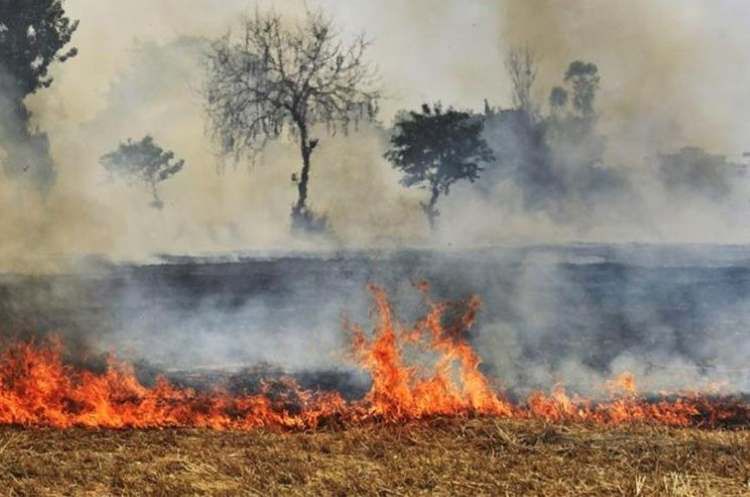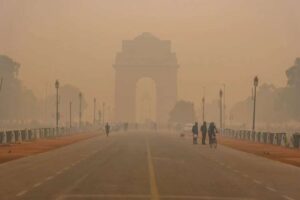
Each autumn, the northern plains of India prepare for a familiar crisis. Satellite images pick up glowing dots across Punjab, Haryana, and Uttar Pradesh — paddy fields set alight to make way for the next crop. Within weeks, Delhi and the wider National Capital Region choke under a toxic haze, schools shut down, flights are disrupted, and hospitals witness a surge in respiratory cases. Despite years of interventions, the practice of stubble burning remains entrenched. The problem persists not because of lack of laws or schemes, but because of a missing balance: incentives for sustainable alternatives must be coupled with deterrent penalties to end this destructive cycle.
The Indian Agricultural Research Institute (IARI) has already recorded 64 farm fires this season, with Punjab leading the count. While the numbers are negligible for now, past data show a sharp spike after the withdrawal of the monsoon, peaking in late October and November. In 2024, Punjab alone accounted for more than 10,900 stubble burning cases, while Uttar Pradesh reported over 6,000. These fires are not isolated rural events.

Their smoke drifts hundreds of kilometres, mixing with urban vehicular emissions and industrial pollutants. Studies by IIT Kanpur and SAFAR confirm that stubble burning contributes more than 40% of Delhi’s PM2.5 levels in peak season. The result is an annual public health emergency, with the Indian Council of Medical Research estimating 1.2 million premature deaths from pollution-related diseases every year.
The economic costs are equally staggering. Millions of workdays are lost, healthcare expenditure rises sharply, and productivity falls in cities already burdened with poor infrastructure. What is often described as an agricultural compulsion has consequences that reverberate far beyond the boundaries of Punjab’s paddy fields.
READ I India’s tax collections surge rests on middle class strain
Laws exist; enforcement does not
On paper, India has ample legal provisions. The Air Act (1981) prohibits the burning of polluting material, and the National Green Tribunal prescribes fines ranging from ₹2,500 to ₹30,000 on violators. The Environment Protection Act once criminalised crop burning, but its provisions were diluted after the farmers’ protests of 2021.
The Supreme Court has grown increasingly impatient. Chief Justice BR Gavai recently suggested that “selective arrests” of farmers would send the right message. The Court underlined that prosecuting only errant officials was insufficient and that cultivators themselves must face consequences. Yet, the political establishment treads cautiously. Farmers, often romanticised as the “annadata”, enjoy a degree of immunity in the public discourse.
Deterrence is ineffective without consistency. Some states have experimented with punitive measures such as red-entry systems that deny defaulting farmers access to grain markets or digital platforms. These methods have shown promise, but enforcement remains patchy, undermined by political calculations and administrative incapacity.
Why farmers burn stubble
To demonise farmers would be simplistic. Their reasons are rooted in structural realities. The Punjab Preservation of Subsoil Water Act of 2009, enacted to conserve groundwater, compels farmers to sow paddy late in the monsoon. As a result, harvesting collides with the narrow sowing window for wheat, leaving barely 10 days to clear fields. Stubble burning, though destructive, is quick and cheap.
Mechanised solutions exist, but they are unaffordable for many. Machines such as Happy Seeders or Super Seeders require 60-horsepower tractors, beyond the means of smallholders. Even hiring them costs around ₹10,000 per season, with waiting times stretching up to two weeks. Subsidies help, but distribution is uneven. Of the 150,000 crop residue management machines available, nearly half are defunct or require repair. The core problem, therefore, is economic viability. As long as paddy enjoys assured procurement at a minimum support price, while alternative crops remain outside this safety net, farmers have little incentive to diversify.
Incentives alone are not enough
Since 2018, the Centre has allocated over ₹3,300 crore for crop residue management. Punjab has repeatedly demanded more — its latest plea for ₹1,200 crore was rejected. Most of these funds have been channelled into subsidising machines. But crop diversification, which addresses the root of the problem, has been underfunded.
There are, however, promising models. Haryana has compensated more than 30,000 farmers for shifting to non-paddy crops and adopting direct seed technology. Digital platforms like Haryana’s “Krishi Yantra” app, developed with Deloitte, have connected farmers to machines in real time, reducing burning incidents. Bio-energy initiatives that convert stubble into ethanol or biomass power hold potential but have been plagued by delays, protests, and weak coordination between the state and Centre.
What emerges clearly is that incentives are necessary but insufficient. Without deterrence, compliance remains optional. Selective but firm penalties, especially on large cultivators who profit from scale, would send a stronger signal. At the same time, smallholders must be cushioned with subsidies, market access, and assured procurement of diversified crops.
The health and climate imperative
The consequences of inaction are stark. The Lancet has linked stubble burning to rising cases of asthma, bronchitis, and cardiovascular diseases. Children and the elderly are the most vulnerable. Beyond health, the climate implications are severe. Stubble burning emits not just carbon dioxide but also methane, which has 25 times the warming potential of CO₂.
Repeated burning depletes soil fertility, destroying microbes and organic matter. Farmers, in effect, compromise the long-term productivity of their own fields for short-term savings. The vicious cycle continues, with declining soil quality demanding ever-higher inputs of fertiliser and water.
A balanced roadmap for the future
Breaking this cycle requires a two-pronged strategy. Incentives must be broadened and deepened. The minimum support price umbrella should be expanded to include a wider range of crops, encouraging diversification away from paddy. Waste-to-energy plants must be built with assured procurement of stubble to create a reliable market. Investments in research and development are essential to produce high-yield, short-duration crop varieties that ease sowing cycles. Digital platforms should be scaled up to link farmers with machines, buyers, and collection systems in real time.
But this must be complemented by penalties applied with fairness. Selective prosecution against habitual offenders with large landholdings, as suggested by the Supreme Court, would act as a deterrent. Repeat violators could be denied market access or subsidies. Monitoring through remote sensing and ground verification should be strengthened to ensure accountability.
The message must be clear: stubble burning is not a harmless rural practice but an assault on public health and the environment. Incentives can soften the transition, but penalties must anchor compliance.
For too long, India has relied on persuasion and subsidies, treating stubble burning as a social issue rather than an environmental crime. The result is an annual replay of smog and suffering in the capital. The time has come to mix carrots with sticks. Farmers deserve support, but society also deserves clean air. Delhi’s winter cannot be held hostage to the convenience of burning fields. Only when incentives are matched with credible penalties will the message sink in: the age of stubble burning must end.
